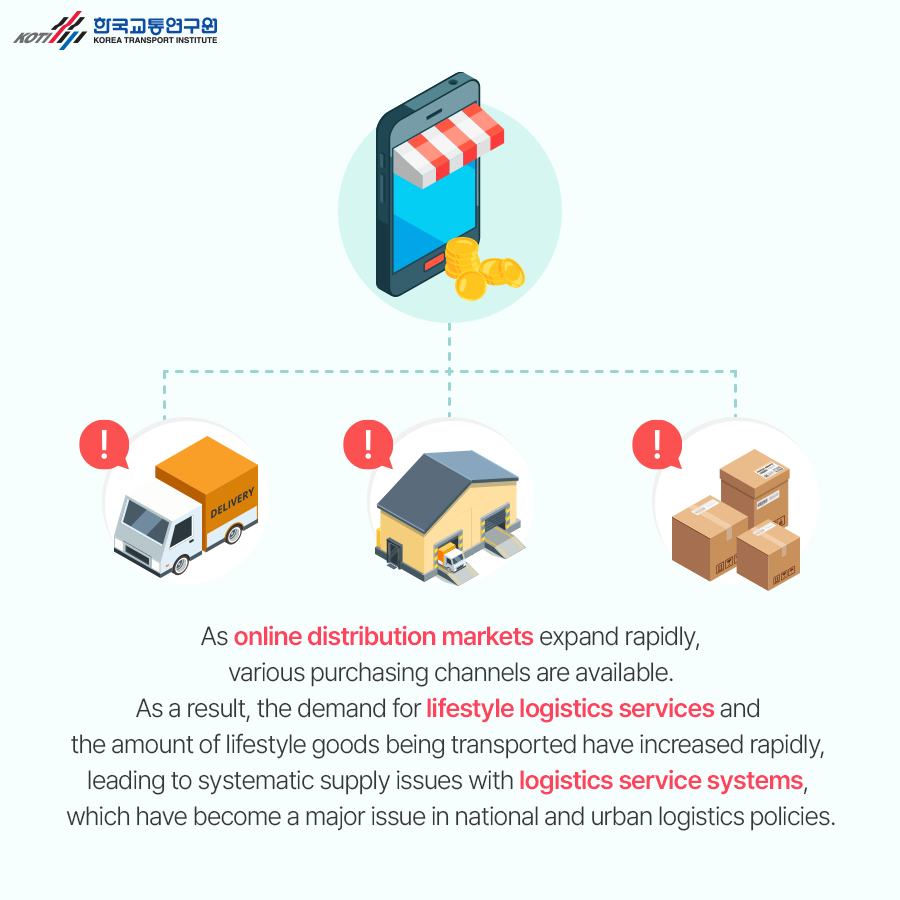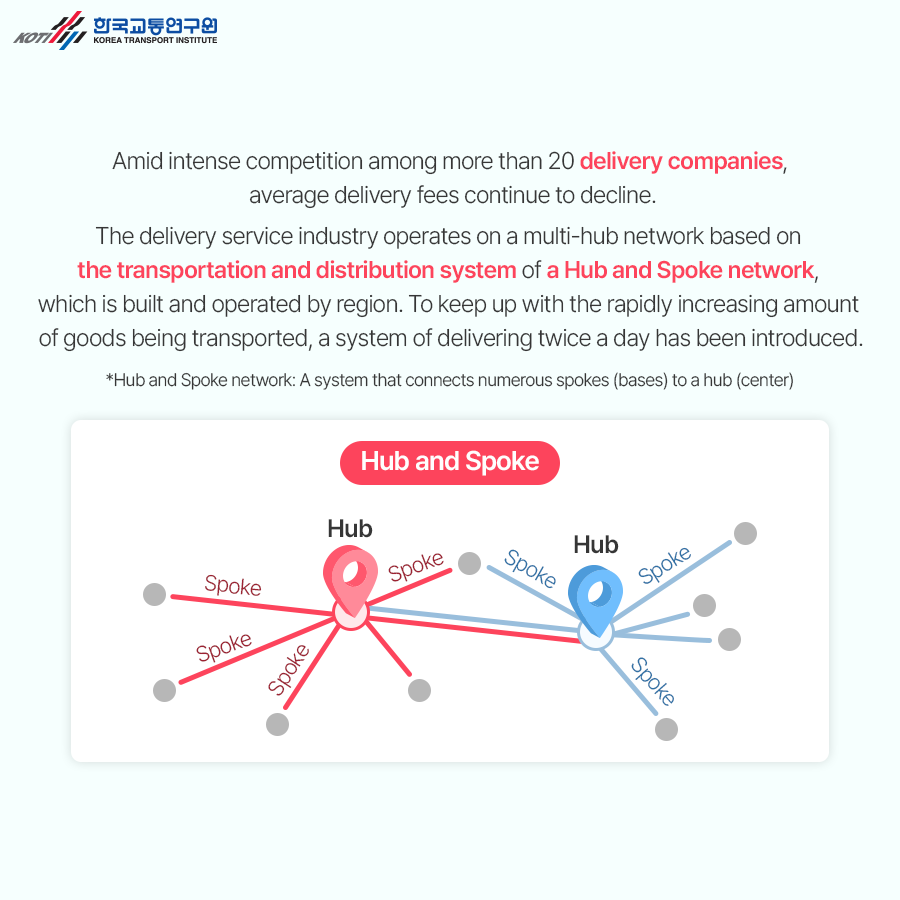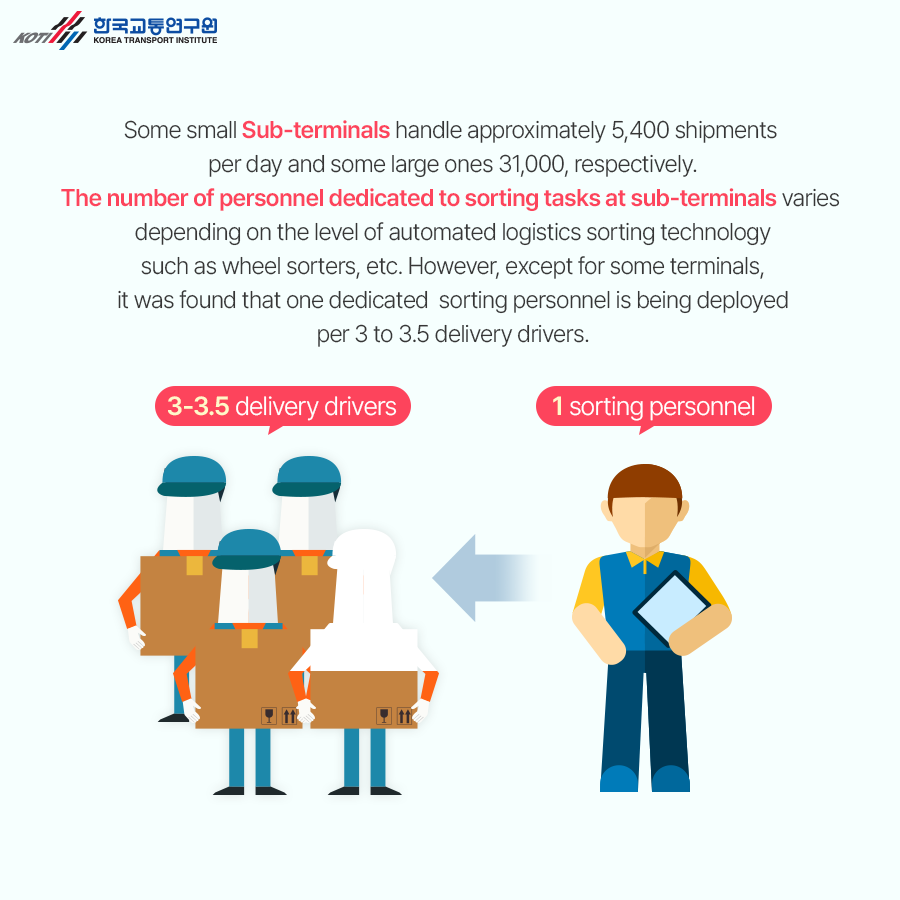Card News

NEWS
KOTI - Korea Transport institute-
# As online distribution markets expand rapidly, various purchasing channels are available.
As a result, the demand for lifestyle logistics services and the amount of lifestyle goods being transported have increased rapidly, leading to systematic supply issues with logistics service systems, which have become a major issue in national and urban logistics policies.
# Since the emergence of social commerce in 2010, rapid growth has been achieved, and the range of products purchased through e-commerce and the age range of users have become more diverse.
According to Korea Integrated Logistics Association, the amount of goods being transported in the domestic delivery service industry is maintaining high-speed growth.
Trend in the growth of the domestic delivery service industry (2000-2020) / Goods (million pieces) / Growth Rate (%).
# As personal mobility and online purchases continue to increase, the parcel delivery platform business is undergoing constant change.
Orders are being sent to delivery riders through mobile app intermediary platforms, and the entire ordering process is completed through mobile devices.
Delivery service work structure / Shipper (restaurant, florist, etc.) / Customer (consumer) / Delivery Rider / Delivery Service Company (local delivery company, branch) / Delivery Service Platform (Vroong, Barogo, Saenggakdaero, Woowa Brothers...) / Intermediary Platform (Baemin, Yogiyo, Coupang Eats, WEMAKEPRICE, etc.).
# Freight delivery agency services are typically comprised of traditional quick-services and on-demand delivery services.
Quick services primarily focus on long-distance B2B deliveries, while on-demand delivery services take over short-distance delivery jobs.
There are two types of processes: one where ordering and shipping are handled separately through different intermediary platforms, and the other where the two platforms are integrated.
In an integrated platform, the order agency company directly hires delivery riders to handle orders they took.
*B2B: Business-to-business transactions / Integrated platform.
# Amid intense competition among more than 20 delivery companies, average delivery fees continue to decline.
The delivery service industry operates on a multi-hub network based on the transportation and distribution system of a Hub and Spoke network, which is built and operated by region. To keep up with the rapidly increasing amount of goods being transported, a system of delivering twice a day has been introduced.
*Hub and Spoke network: A system that connects numerous spokes (bases) to a hub (center).
# Delivery service begins with the customer's dispatch process and goes through stages of pickup, local transportation, sorting, long-distance transportation, sorting, and delivery.
The shipment collected by the pickup carrier is gathered at the sub-terminal, and the shipment sorted by region at the sub-terminal is again gathered at the hub terminal.
At the hub terminal, freight is sorted by sender and sent back to the sub-terminal in each region, where it is sorted again by delivery destination and delivered to customers by delivery drivers.
# It appears that the average amount of goods handled per delivery driver is approximately 163 packages.
The average daily delivery distance has been calculated to be about 42km.
Most delivery drivers are reported to receive a per-piece commission of around 800 to 850 won, and their average monthly income ranges from 3 to 10 million won.
Average amount of goods handled per delivery driver / about 163 packages / Average daily delivery distance / about 42km / Per-piece commission / around 800 to 850 won / Average monthly income / 3 to 10 million won
# Some small Sub-terminals handle approximately 5,400 shipments per day and some large ones 31,000, respectively.
The number of personnel dedicated to sorting tasks at sub-terminals varies depending on the level of automated logistics sorting technology such as wheel sorters, etc. However, except for some terminals, it was found that one dedicated sorting personnel is being deployed per 3 to 3.5 delivery drivers.
3-3.5 delivery drivers / 1 sorting personnel
# As the lifestyle logistics service industry grows, there is a need for a flexible service supply system, changes in hub terminals, and improvements in smart logistics solutions.
In the future, delivery service providers will expand. And with improvement in technology, various means of transportation such as drones and robots, will be adopted and replace the delivery riders.
# 5 strategies for improving lifestyle logistics services in the New Normal era
-Increasing delivery personnel and securing additional and larger vehicles to increase transport capacity.
-Increasing the capacity of lifestyle logistics centers through the establishment and smartification of hub and sub-terminals.
-Securing last-mile infrastructure and building advanced delivery systems.
-Improving the quality of jobs related to lifestyle logistics through the improvement of fare structures and the establishment of protection and empowerment systems for workers.
-Establishing a support system for the innovation of lifestyle logistics networks.
# The delivery volume is expected to continue to increase, but securing delivery personnel will become the most difficult problem that courier companies will have to solve in the future due to the decline in the working population.
Recently, the development of advanced equipment such as autonomous vehicles, delivery robots, and drones in the last-mile delivery sector has been progressing rapidly. This is an inevitable choice to cope with future situations where resource availability becomes difficult despite the rapid increase in delivery volume.
*last-mile delivery : a neologism that has emerged as distribution companies focus on delivery quality as a means of service differentiation to increase customer satisfaction.
* This card news was created by partially modifying and supplementing the Korea Transport Institute's research and development fund report titled "Post-COVID-19 Era, New Normal Traffic System Innovation Strategy (2) - Improvement Strategies for Environment of Lifestyle Logistics Industry Based on On-site Survey Results".











